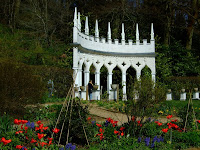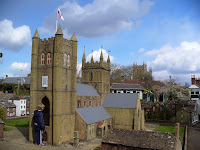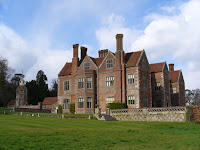
Many projects in the UK seem to run over time and over budget and the one we visited today was no exception. The Spinnaker Tower in Portsmouth ran 5 years over time and cost 4 times it's original budget of £9 million but, nevertheless, we enjoyed our visit to this, the tallest accessible structure in the UK outside of London.
Visibility was excellent, and it is in a beautiful spot with a harbour; inlets; and ferries going across the river mouth,

to the Isle of Wight and further afield to Europe: so plenty to see and changing all the time.

Portsmouth also has an excellent visitor attraction in its Historic Dockyards. We had purchased a special combination ticket, and we only just managed to see everything in the one day. A more leisurely visit could be spread over a weekend. We choose to take our included harbour tour after the Tower. This was a lovely sea-level look around the area we had seen from above, with a commentary.
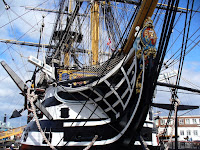
We found all of the attractions in the Dockside area very interesting, but probably enjoyed the restored Victory best of all. Nelson's flagship was rebuilt in 1922, and it is an amazing look at warships of the 1800s.
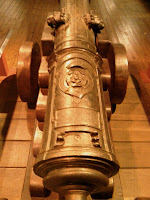
Older still is the recovered wreck of Henry 8th’s warship, the Mary Rose. This is still in a sealed building, being sprayed with a mixture of wax and water. The museum of artefacts found on and around the ship is incredible. The fact that so many objects survived 500 years under water is amazing. There are also many bronze cannon, looking like new. One amazing fact is that it took 36 acres of oak forest to build a relatively small ship like the Mary Rose: one wonders how many acres for something the size of the Victory.

The most 'modern' ship is HMS Warrior. Launched in 1860, she combined sail and steam engines, and is a fascinating look at life at sea 150 years ago.
There is a Navy Museum, with a room devoted to Admiral Nelson. It's interesting to realise he was a celebrity figure in his day, in a similar way to popular footballers today in the UK. Adjoining this museum, is a room housing the original sail from his ship The Victory, complete with all the cannon holes and major vertical rip.

It had been put aside to mend, mislaid, and then rediscovered. It is thus the only surviving sail from that period and the largest conserved fabric artefact in the world.
The whole area has been redeveloped, with a harbour-side walk, a large Outlet Shopping Centre beside the Spinnaker Tower. All in all a very full day out, and one which we would recommend.
 The Vale of Berkley was our focus today as we visited towns that are situated on both sides of the Severn River. This area has been settled for aeons, as evidenced by a walk we did around Minchampton and it's Common, following old prehistoric earthworks. The whole area around there has stunning views over the valleys on either side.
The Vale of Berkley was our focus today as we visited towns that are situated on both sides of the Severn River. This area has been settled for aeons, as evidenced by a walk we did around Minchampton and it's Common, following old prehistoric earthworks. The whole area around there has stunning views over the valleys on either side.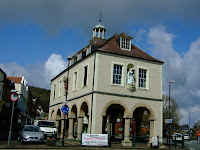 From Michampton we drove down through Uley and Dursley to Berkley. This town is fairly boring, but Berkley Castle is impressive, not least for still belonging to the Berkley family since it's beginnings in the 12th century.
From Michampton we drove down through Uley and Dursley to Berkley. This town is fairly boring, but Berkley Castle is impressive, not least for still belonging to the Berkley family since it's beginnings in the 12th century.  The tour started in the 12th century Keep, and moved on through the more 'modern' 14th century parts including the Great Hall. There is a lot of history associated with the family’s ownership of the house, and we were shown the wall that Cromwell's troops took 3 days to blast through. The family negotiated with Cromwell to keep their house, on the condition they did not rebuild the breach in the walls.
The tour started in the 12th century Keep, and moved on through the more 'modern' 14th century parts including the Great Hall. There is a lot of history associated with the family’s ownership of the house, and we were shown the wall that Cromwell's troops took 3 days to blast through. The family negotiated with Cromwell to keep their house, on the condition they did not rebuild the breach in the walls.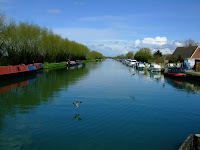 We also saw the cell where Edward II was held for 5 months while his captors hoped he would die from the fumes emanating from the rotting corpses in the dungeon just outside the cell. It is rumoured that when this failed his captors took matters into their own hands and killed the King in a most gruesome and painfully unpleasant manner.
We also saw the cell where Edward II was held for 5 months while his captors hoped he would die from the fumes emanating from the rotting corpses in the dungeon just outside the cell. It is rumoured that when this failed his captors took matters into their own hands and killed the King in a most gruesome and painfully unpleasant manner. North of here we visited the Gloucester Canal, second only in size to the Manchester Ship Canal. Our final stop was the fascinating town of Frampton On Severn, which is close to but actually not on the Severn at all. The interesting feature of this town is the 22-acre green, which makes a very pleasant walk around the old and attractive manor houses, and several village ponds.
North of here we visited the Gloucester Canal, second only in size to the Manchester Ship Canal. Our final stop was the fascinating town of Frampton On Severn, which is close to but actually not on the Severn at all. The interesting feature of this town is the 22-acre green, which makes a very pleasant walk around the old and attractive manor houses, and several village ponds.





